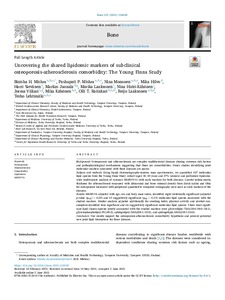Hae
Aineistot 1-10 / 21
Long-term tracking and population characteristics of lipoprotein (a) in the Cardiovascular Risk in Young Finns Study
<p>Background and aims</p><p>Lipoprotein (a) (Lp(a)) is a causal risk factor for cardiovascular diseases and its levels are under strict genetic control. Therefore, it is hypothesized that the concentration of Lp(a) remains ...
Weight gain in infancy and markers of cardiometabolic health in young adulthood
Aim We studied whether repeatedly measured weight gain from birth up to age 2 years associated with cardiometabolic health in young adulthood. Methods Using the data collected in the longitudinal Special Turku Coronary ...
Uncovering the shared lipidomic markers of subclinical osteoporosis-atherosclerosis comorbidity: The Young Finns Study
<p>Background: Osteoporosis and atherosclerosis are complex multifactorial diseases sharing common risk factors and pathophysiological mechanisms suggesting that these are comorbidities. Omics studies identifying joint ...
Sydän- ja verisuonitautien ehkäisy kannattaa aloittaa jo vauvasta - STRIP-tutkimus näyttää miksi ja miten
Satunnaistetussa STRIP-tutkimuksessa 562 tervettä lasta sai tyydyttyneen rasvan saannin vähentämiseen tähtäävää ravitsemusneuvontaa kahdeksan kuukauden iästä alkaen 20 vuoden ikään asti, ja 545 saman ikäistä lasta seurattiin ...
Genetic and observational evidence: No independent role for cholesterol efflux over static high-density lipoprotein concentration measures in coronary heart disease risk assessment
<p>Background <br></p><p>Observational findings for high-density lipoprotein (HDL)-mediated cholesterol efflux capacity (HDL-CEC) and coronary heart disease (CHD) appear inconsistent, and knowledge of the genetic architecture ...
Does better education mitigate risky health behavior? A mendelian randomization study
<p><br></p><p>Education and risky health behaviors are strongly negatively correlated. Education may affect health behaviors by enabling healthier choices through higher disposable income, increasing information about the ...
Fatty liver index predicts incident risk of prediabetes, type 2 diabetes and non-alcoholic fatty liver disease (NAFLD)
Aims To investigate the association between overweight/obesity and fatty liver index (FLI) on the odds of incident prediabetes/type 2 diabetes and non-alcoholic fatty liver disease (NAFLD) in 2020 participants after 10 ...
An Infancy-Onset 20-Year Dietary Counselling Intervention and Gut Microbiota Composition in Adulthood
The randomized controlled Special Turku Coronary Risk Factor Intervention Project (STRIP) has completed a 20-year infancy-onset dietary counselling intervention to reduce exposure to atherosclerotic cardiovascular disease ...
IDO activity forecasts obesity in males and premenopausal females in a 10-year follow-up study:The Cardiovascular Risk in Young Finns Study
<p>Background and aims: Indoleamine 2,3-dioxygenase (IDO) is an intracellular enzyme associated with artery wall inflammation. Previous studies have verified correlation between IDO activity and early signs of atherosclerosis especially in females. We aimed to elucidate the relationship between an estimate of IDO activity and atherosclerotic risk factors related to non-alchohol-fatty liver (NAFLD) in a 6- and 10-year follow-up.<br></p><p>Methods: Estimates of IDO activity along with complete risk factor data were measured from females (n = 506; age 24-39) and males (n = 421; age 24-39) in 2001. Risk factor measurements were conducted again in 2007 and 2011. Statistical examinations were carried out by Pearson correlation and risk ratio analysis.<br></p><p>Results: In females, age-adjusted IDO correlated with body mass index (BMI) (p = 0.0008), waist (p = 0.0009), C reactive protein (CRP) (p = 0.0014) and logarithmically modified triglycerides (p = 0.0488) in 2007. Correlation remained significant with BMI (p = 0.0007) and waist (p = 0.0063) in 2011. In males, age-adjusted IDO correlated with waist (p = 0.0367) and high-density lipoprotein cholesterol (HDL-C) (p = 0.0489) in 2007. Correlation remained significant with HDL-C (p = 0.0348) in 2011. In risk ratio analysis, relationship between IDO and obesity was confirmed in females after 10 years (RR = 1.026, p = 0.0147, 95% CI) and in males after 6 and 10 years (RR = 1.019, p = 0.0091, 95% CI and RR = 1.015, p = 0.0404, 95% CI, respectively) when the data was adjusted for age and BMI.Conclusions: IDO activity correlated with obesity and factors related to NAFLD, namely obesity of visceral type, hypertriglyceridemia and CRP (in females), well-characterized risk factors for diabetes and atherosclerosis in 6 and 10-year follow-up in males and premenopausal females.</p>...
Longitudinal analysis of risk of Non-Alcoholic Fatty Liver Disease (NAFLD) in adulthood
<div>Background and aims: Childhood overweight/obesity, not metabolic health, is associated with increased risk for adult non-alcoholic fatty liver disease. However, the increased risk associated with childhood overweight/obesity ...









